Want to know if something has been written by a human or produced by AI? Read on to find out how!
Overview
As Artificial Intelligence (AI) becomes more widespread, more and more text is being generated by AI text generators. An AI text generator is an advanced tool that generates realistic text based on a deep learning algorithm that is trained on a large corpus of text. The algorithm can learn the structure of language and generate text that is both grammatically correct and sounds natural. AI is being used to create emails, school essays, blog posts, website content, social media, news stories, and possibly technology articles (but not on Daves’s Computer Tips, of course). In addition, as AI technology rapidly advances, it will become increasingly difficult to determine whether the content was written by a human.
AI content detectors are advanced tools that can distinguish between human-written content and text generated by ChatGPT, Bard, or other AI tools. The detectors use algorithms or even AI to detect patterns and word choices that lead to a higher probability of AI detection. These patterns include word repetition, lack of natural flow or structure, a generic tone, and are typically shorter than human-written pieces because they rely on algorithms rather than creative thought processes.
I decided to test six of the current AI content detectors with my recent DCT article on Pi-Day and the mathematical constant pi (π) to determine whether I am AI or human.
GPTZero
GPTZero calls itself “The World’s #1 AI Detector” and claims to be the “best and most reliable AI detector”. It was written by a 22-year-old Princeton University student. GPTZero is free to try. Registered users can check up to 5,000 characters per document and three files per batch upload. They also offer a Pro plan.
When you open GPTZero, it presents you with a box to paste the text into, or you can select a file to upload. Then you click the “Get Results” button.
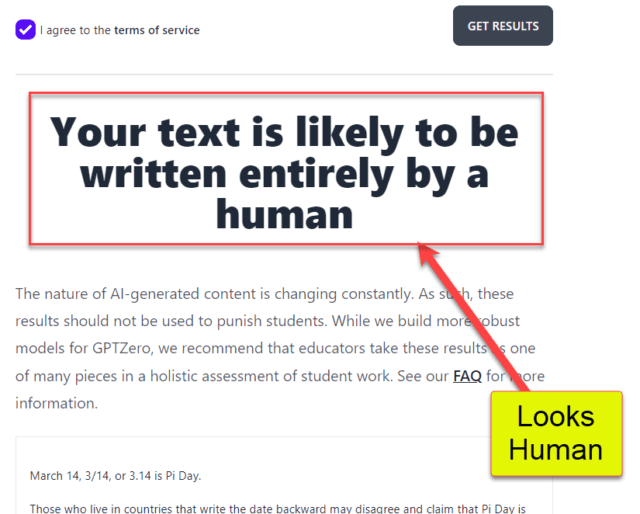
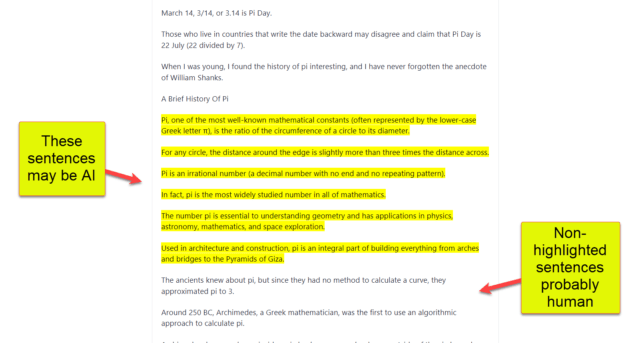
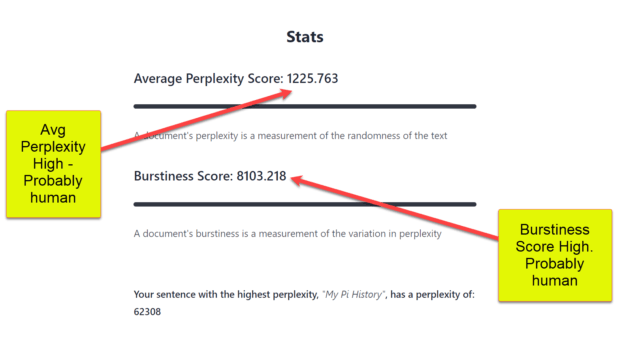
As you can see, GPTZero states that my article is “likely to be written entirely by a human” Yeah! GPTZero highlights sentences in yellow that could be AI. In my article, it highlighted the sentences that discussed the definition of what pi is. This sounds reasonable since all methods of defining pi probably sound similar. GPTZero also gives a “perplexity score” (the complexity of the text’s randomness) and a “burstiness score” (the variation in perplexity). I looked but could not find any information on what these scores mean, but I assume that my article’s scores were high – indicating human content.
Content At Scale
Content at Scale is an AI writing platform for SEO marketers. Or, they help clients use AI to create content. However, they have also developed a free AI Detector that can be used to detect AI content. Content at Scale claims their AI Detector is “best-in-class for detecting AI content”.
After opening the AI Detector, you are presented with a box to enter text. Up to 25,000 characters are used in the analysis. After pasting, click the “Check For AI Content” button.
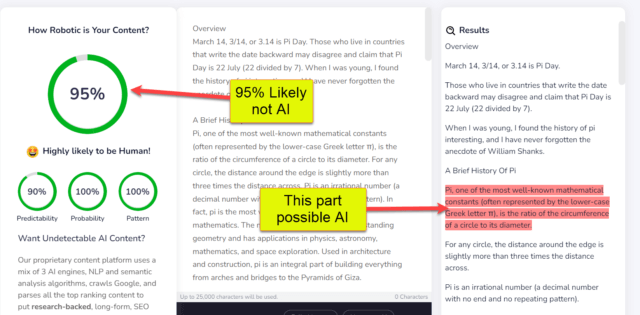
Content at Scale indicates that my article is 95% “Highly likely to be human” (Yeah again!) with Predictability at 90% and Probability and Pattern both at 100%. The AI Detector highlights sentences that are most likely to be AI-generated in red, sentences that are possibly AI-generated in orange, and sentences that are unclear if they are AI-generated in yellow.
AI Text Classifier
AI Text Classifier is a free-to-use AI text detector from OpenAI, the developer of ChatGPT. OpenAI states that the AI Text Classifier “is to foster conversation about the distinction between human-written and AI-generated content”. Note that a login is required, but you can use your ChatGPT login if you have one.
When you arrive at the AI Text Classifier, a box is presented to paste the text into. AI Text Classifier requires a minimum of 1,000 characters, which is approximately 150-250 words. After pasting your text, select the “Submit” button.

Ai Text Classifier simply presents a box with the result. There are three results: possibly AI-generated, likely AI-generated, and very unlikely AI-generated. In my case, the result was “The classifier considers the text to be very unlikely AI-generated.” Woohoo!
ZeroGPT
ZeroGPT is another free-to-use AI text detector. ZeroGPT claims to be 98% accurate and uses DeepAnalyse™ Technology.
Upon opening ZeroGPT, a box is presented that allows for either pasting text or uploading a file. There is a limit of 50,000 characters.

At the top, ZeroGPT displays a meter with a percentage it believes is AI-generated and an assessment. It also highlights text it suspects to be generated by AI.
ZeroGPT scored my article at 18.16% and gave a “Your Text is Most Likely Human written” assessment.
Writer
Writer AI Content Detector is another free-to-use detector. Writer is a simple detector that only allows 1500 characters (about 300 words). Enter the text and the detector will display a percentage on the right.
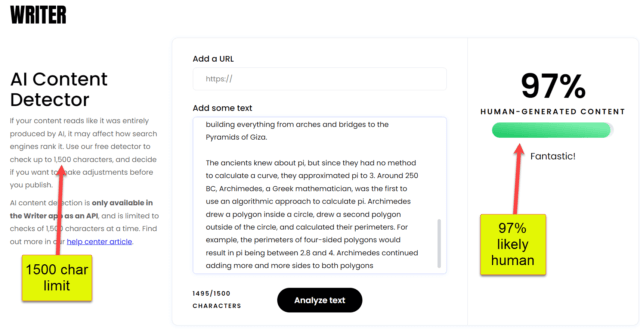
As you can see, Writer shows the first 1495 characters of my article to be 97% likely human-generated content.
Originality AI
Originality AI bills itself as “The Most Accurate AI Content Detector and Plagiarism Checker Built for Serious Content Publishers.” It is not free; it is a business-oriented product aimed at content providers and they charge $.01 per 100 words. However, if you sign up, they will give you some credits to test the system. Originality AI saves your scans for later review.


Originality has two result pages: AI Detection and Plagiarism. On the AI Detection page, Original and AI percentages are displayed. It also highlights likely AI text in yellow and likely human text in green. On the Plagiarism page, it gives a plagiarism score and highlights the possibly plagiarized text in purple. It also displays the website where the plagiarism occurred.
For my results, it found that 98% of my article was human-generated and 2% was possibly AI-generated. On the plagiarism page, it found that my article was 81% plagiarized and those plagiarized parts came 100% from DCT, of course! I found it strange that it did not have a 100% plagiarism score since it was the same article.
Bottom Line
As AI continues to rapidly improve, more and more content will be generated by AI. While the quality of AI-generated content will improve, it will still contain errors and lack the creative thought processes of a human. Still, it will be increasingly difficult to tell what is what. These AI content detectors can help with that.
Share your thoughts on AI-generated content in the comments.
—

Nice piece about AI vs human detection, John. You hit all the key points, the fear, the impact, the dangers and how to deal with AI. It’s a technological innovation that will obviously disrupt our world, so ways expected, many, shockingly unexpected. Your piece should trigger much essential debate pertaining to AI and its impact on our world.
Thanks Richard, almost everyone looks at AI and just sees the “new shiny” technology -look it can create an image, it can create a batch program, it can answer a question, etc.
All technologies that have come before in human history (from the invention of fire and primitive tools all the way to the most recent advancements in computing, medicine, space, etc.) have lacked intelligence. AI is completely different. Not many of us are capable of seeing nor understanding AI and its true impact. You are correct, AI is going to cause many disruptions.
Ouch. Big ouch. (Written by a human.)